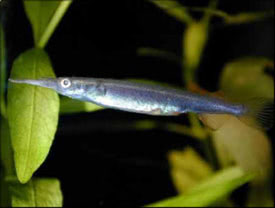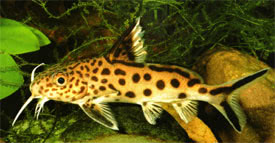
 Magyarul / Hungarian
Magyarul / Hungarian


- Scientific name: Dermogenys pusilla
- Synonyms: Dermogenys pusillus
- Common name: Half beak
- Group: Livebearers
- Habitat: Asia; Thailand, Malaysia
- Size: Males:5 cm, Females:6-7 cm
- Biotope: Shallow areas in the coastal areas of Southeast Asia. Found in both fresh and brackish water.
- Social behavior: A good community fish to combine with other live bearing species that can toleratethe addition of salt.Fish are best kept in a ratio of 2-3 females to one male, which helps eliminate male harassmentof females.When first introduced, Halfbeaks are nervous fish that tend to be timid. However, once acclimate, Halfbeaks becomelively fish.Males may often battle harmlessly with each other.
- Diet: Live, insects, mosquito larvae, small crustaceans, worms, flakes. Halfbeaks are surface-feeders.
- Breeding: Easy
- Tank: Minimum 100 litres
- Population: 10 fishes for 100 litre
- Decoration: Floating plants.
- Temperature: 25-27 °C
- pH: 7-8
- Hardness: 10-20 NK°
- Lifespan: 4 years
Description: Slender, long and Pike like with moderate lateral compression. The most obvious feature is the long protruding lower jaw. This jaw cannot move. The upper jaw is short and is connected to and moves with the skull. I have read that this is very unusual for a vertebrate. The Dorsal and Anal fins are set way back near the start of the tail the tail fin is somewhat oval in shape. The front bottom part of the Anal fins forms a Gonopodium, thus making the Half beak a livebearer. The first one is small and lies in line with the Ventral fins. The second Dorsal is much larger and lies in line with the similar shaped Anal fin. In juveniles and females the second dorsal and the anal fins are rounded, while in adult males they are elongated and pointed to separations at the tips.
A very beautiful fish in its' own way . The most common coloration seen have a Silver to gray body with hints of Green or blue in it. The belly area is also Silver sometimes leaning toward White. The sides have the same sheen of Blue or Green as the general body appearance. The lower jaw has two colored lines on each side. One being Red and the other Black. The Dorsal,Anal and caudal fins are a pale yellow in color. Males Have a distinctive Red area in the front of the Dorsal fin. The iris in the eye is Bright Green. The females are generally paler in color overall.
The tank should be as large as possible with the length being much more important than the depth. The rest of the tank can be planted anyway you like but some of the plants around the edges should reach the surface. The addition of some floating plants will also help mimic it's natural habitat. Leave some open space areas for swimming. Not the easiest fish to care for, they require the addition of some sea salt to maintain their best health. Provide gentle filtration with a slight water currant. They will accept flake and frozen food, but they will fare better with live insects like mosquito larvae, fruit flies and daphinia if you can find it. The addition of a supplement containing vitamin D and A is an absolute necessity if you wish to breed them. Care must be taken when they are first introduced to the aquarium, if they get startled and dash about they may injure their lower jaw and this will lead to certain death.
Being a livebearer the Half beak gives birth to live young. Wild caught specimens can give birth to a couple of viable broods, but subsequent ones usually seem to fail. This is thought to be caused by the vitamin deficiency described above. During spawning the male will swim up to the female and nudge her sides with his beak. He will keep this up until she accepts him. The gestation period is also quite long and can last up to eight weeks. The broods are generally small. The newly born fry can be fed almost immediately on the finest flake food or baby Brine shrimp. At birth the upper and lower jaws are the same length which develop as the fry mature.


















